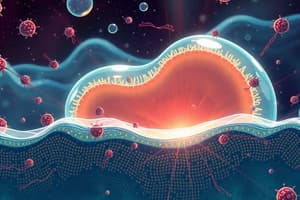Podcast
Questions and Answers
What are the three lines of defense in the immune system?
What are the three lines of defense in the immune system?
- First Line, Third Line, Fourth Line
- Second Line, Third Line, Fourth Line
- First Line, Second Line, Fourth Line
- First Line, Second Line, Third Line (correct)
What is the first line of defense?
What is the first line of defense?
Physical and chemical barriers such as epithelial cell layers of the skin, mucosal tissues, and glandular tissues.
What is the second line of defense?
What is the second line of defense?
Cellular immune responses.
The skin is a part of the first line of defense.
The skin is a part of the first line of defense.
Cellular immune responses are part of the third line of defense.
Cellular immune responses are part of the third line of defense.
Dendritic cells present pathogens to lymphocytes in the third line of defense.
Dendritic cells present pathogens to lymphocytes in the third line of defense.
The first line of defense is the most specific defense mechanism.
The first line of defense is the most specific defense mechanism.
Flashcards
What is immunology?
What is immunology?
The study of how the host (our body) defends itself against foreign substances.
What is an antigen?
What is an antigen?
A foreign substance that triggers an immune response. It can be a microbe, a toxin, or even parts of a foreign cell.
What is immunity?
What is immunity?
The state of being protected from a particular disease.
What is innate immunity?
What is innate immunity?
Signup and view all the flashcards
What is adaptive immunity?
What is adaptive immunity?
Signup and view all the flashcards
What is the first line of defense in innate immunity?
What is the first line of defense in innate immunity?
Signup and view all the flashcards
What is the second line of defense in innate immunity?
What is the second line of defense in innate immunity?
Signup and view all the flashcards
What is the third line of defense in innate immunity?
What is the third line of defense in innate immunity?
Signup and view all the flashcards
What is phagocytosis?
What is phagocytosis?
Signup and view all the flashcards
What are cytokines?
What are cytokines?
Signup and view all the flashcards
What are NK cells?
What are NK cells?
Signup and view all the flashcards
What are dendritic cells?
What are dendritic cells?
Signup and view all the flashcards
What are B lymphocytes (B cells)?
What are B lymphocytes (B cells)?
Signup and view all the flashcards
What are T lymphocytes (T cells)?
What are T lymphocytes (T cells)?
Signup and view all the flashcards
What are antigen presenting cells (APCs)?
What are antigen presenting cells (APCs)?
Signup and view all the flashcards
What are antibodies?
What are antibodies?
Signup and view all the flashcards
What is immune memory?
What is immune memory?
Signup and view all the flashcards
What is specificity in adaptive immunity?
What is specificity in adaptive immunity?
Signup and view all the flashcards
What is systemic in adaptive immunity?
What is systemic in adaptive immunity?
Signup and view all the flashcards
Why is lactic acid important in innate immunity?
Why is lactic acid important in innate immunity?
Signup and view all the flashcards
How do cilia work in innate immunity?
How do cilia work in innate immunity?
Signup and view all the flashcards
Why is stomach acid important in innate immunity?
Why is stomach acid important in innate immunity?
Signup and view all the flashcards
Why is urine important in innate immunity?
Why is urine important in innate immunity?
Signup and view all the flashcards
What is lysozyme?
What is lysozyme?
Signup and view all the flashcards
Why are normal flora important in innate immunity?
Why are normal flora important in innate immunity?
Signup and view all the flashcards
Study Notes
Innate Immunity Defense Barriers
- Innate immunity has multiple defense barriers
- First Line: Physical and chemical barriers like skin, mucosal tissues (respiratory, digestive, urogenital), and glandular tissues (salivary, lacrimal, mammary)
- Second Line: Cellular immune responses triggered by receptors recognizing pathogen components. White blood cells engulf and destroy microbes via phagocytosis. Cells produce antimicrobial substances and cytokines/chemokines to recruit cells and create inflammation.
- Third Line: Dendritic cells present pathogens to lymphocytes, triggering adaptive immunity.
Innate Immunity Mechanisms
- Examples of mechanisms and their functions:
- Skin and mucous membranes: retard microbe entry
- Lactic acid: inhibits microorganism growth
- Cilia: remove pathogens from respiratory tract
- Stomach acid (low pH): prevents pathogen growth
- Urine: flushes pathogens from the body
- Lysozyme: attacks pathogen cell walls
- Normal flora: competes with pathogens, produces antimicrobial peptides
- Cells: participate in phagocytosis (e.g., NK cells destroying target cells)
- Pathogen recognition receptors (PRRs, e.g., Toll-like receptors): assist phagocytic cells in recognizing pathogens.
Adaptive Immunity
- Adaptive (or acquired) immunity is a specific system protecting the body from microbes and abnormal cells. It's activated by foreign substances.
- Characteristics:
- Specific: for individual pathogens
- Systemic: immunity isn't limited to infection site
- Memory: increased response to repeated exposure to the same pathogen.
- Comparison of Natural and Adaptive Immunity:
Feature Natural Immunity Adaptive Immunity Specificity Non-specific Specific Response Time Rapid (minutes to hours) Slow (days to weeks) Memory No Yes Soluble Components Antimicrobial peptides and proteins Antibodies Major Cell Types Phagocytes, NK cells, dendritic cells T cells, B cells, APCs (antigen-presenting cells)
Studying That Suits You
Use AI to generate personalized quizzes and flashcards to suit your learning preferences.




